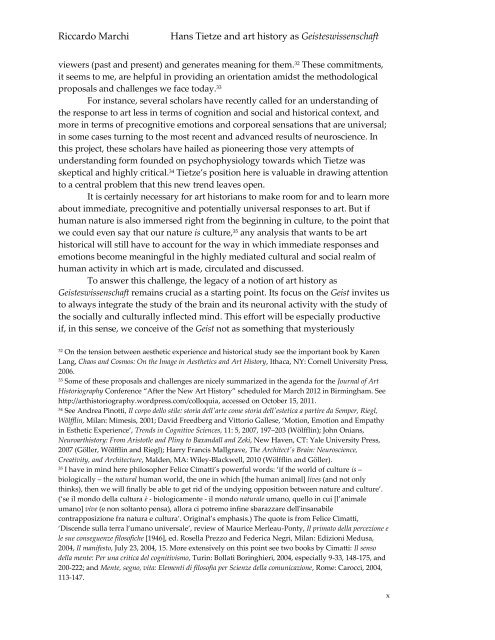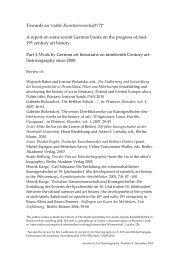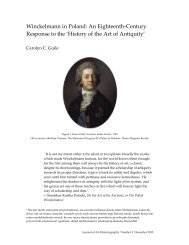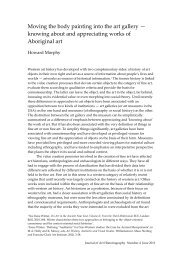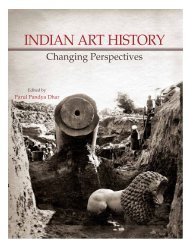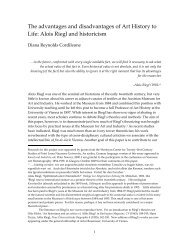Geisteswissenschaft - Journal of Art Historiography
Geisteswissenschaft - Journal of Art Historiography
Geisteswissenschaft - Journal of Art Historiography
Create successful ePaper yourself
Turn your PDF publications into a flip-book with our unique Google optimized e-Paper software.
Riccardo Marchi Hans Tietze and art history as <strong>Geisteswissenschaft</strong><br />
viewers (past and present) and generates meaning for them. 32 These commitments,<br />
it seems to me, are helpful in providing an orientation amidst the methodological<br />
proposals and challenges we face today. 33<br />
For instance, several scholars have recently called for an understanding <strong>of</strong><br />
the response to art less in terms <strong>of</strong> cognition and social and historical context, and<br />
more in terms <strong>of</strong> precognitive emotions and corporeal sensations that are universal;<br />
in some cases turning to the most recent and advanced results <strong>of</strong> neuroscience. In<br />
this project, these scholars have hailed as pioneering those very attempts <strong>of</strong><br />
understanding form founded on psychophysiology towards which Tietze was<br />
skeptical and highly critical. 34 Tietze’s position here is valuable in drawing attention<br />
to a central problem that this new trend leaves open.<br />
It is certainly necessary for art historians to make room for and to learn more<br />
about immediate, precognitive and potentially universal responses to art. But if<br />
human nature is also immersed right from the beginning in culture, to the point that<br />
we could even say that our nature is culture, 35 any analysis that wants to be art<br />
historical will still have to account for the way in which immediate responses and<br />
emotions become meaningful in the highly mediated cultural and social realm <strong>of</strong><br />
human activity in which art is made, circulated and discussed.<br />
To answer this challenge, the legacy <strong>of</strong> a notion <strong>of</strong> art history as<br />
<strong>Geisteswissenschaft</strong> remains crucial as a starting point. Its focus on the Geist invites us<br />
to always integrate the study <strong>of</strong> the brain and its neuronal activity with the study <strong>of</strong><br />
the socially and culturally inflected mind. This effort will be especially productive<br />
if, in this sense, we conceive <strong>of</strong> the Geist not as something that mysteriously<br />
32 On the tension between aesthetic experience and historical study see the important book by Karen<br />
Lang, Chaos and Cosmos: On the Image in Aesthetics and <strong>Art</strong> History, Ithaca, NY: Cornell University Press,<br />
2006.<br />
33 Some <strong>of</strong> these proposals and challenges are nicely summarized in the agenda for the <strong>Journal</strong> <strong>of</strong> <strong>Art</strong><br />
<strong>Historiography</strong> Conference “After the New <strong>Art</strong> History” scheduled for March 2012 in Birmingham. See<br />
http://arthistoriography.wordpress.com/colloquia, accessed on October 15, 2011.<br />
34 See Andrea Pinotti, Il corpo dello stile: storia dell'arte come storia dell'estetica a partire da Semper, Riegl,<br />
Wölfflin, Milan: Mimesis, 2001; David Freedberg and Vittorio Gallese, ‘Motion, Emotion and Empathy<br />
in Esthetic Experience’, Trends in Cognitive Sciences, 11: 5, 2007, 197–203 (Wölfflin); John Onians,<br />
Neuroarthistory: From Aristotle and Pliny to Baxandall and Zeki, New Haven, CT: Yale University Press,<br />
2007 (Göller, Wölfflin and Riegl); Harry Francis Mallgrave, The Architect's Brain: Neuroscience,<br />
Creativity, and Architecture, Malden, MA: Wiley-Blackwell, 2010 (Wölfflin and Göller).<br />
35 I have in mind here philosopher Felice Cimatti’s powerful words: ‘if the world <strong>of</strong> culture is –<br />
biologically – the natural human world, the one in which [the human animal] lives (and not only<br />
thinks), then we will finally be able to get rid <strong>of</strong> the undying opposition between nature and culture’.<br />
(‘se il mondo della cultura è - biologicamente - il mondo naturale umano, quello in cui [l’animale<br />
umano] vive (e non soltanto pensa), allora ci potremo infine sbarazzare dell'insanabile<br />
contrapposizione fra natura e cultura’. Original’s emphasis.) The quote is from Felice Cimatti,<br />
‘Discende sulla terra l’umano universale’, review <strong>of</strong> Maurice Merleau-Ponty, Il primato della percezione e<br />
le sue conseguenze filos<strong>of</strong>iche [1946], ed. Rosella Prezzo and Federica Negri, Milan: Edizioni Medusa,<br />
2004, Il manifesto, July 23, 2004, 15. More extensively on this point see two books by Cimatti: Il senso<br />
della mente: Per una critica del cognitivismo, Turin: Bollati Boringhieri, 2004, especially 9-33, 148-175, and<br />
200-222; and Mente, segno, vita: Elementi di filos<strong>of</strong>ia per Scienze della comunicazione, Rome: Carocci, 2004,<br />
113-147.<br />
x


